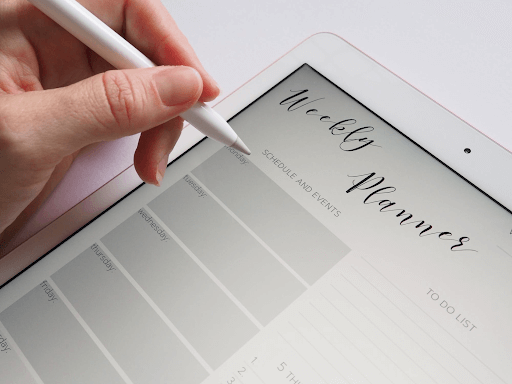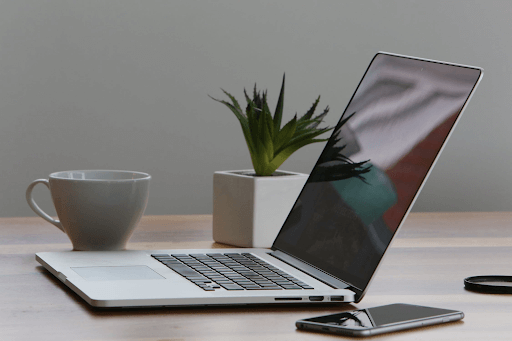Did you ever wish that you could focus on nothing but your work for a few hours, without any disruptions? If your answer is yes, you definitely need to set up your own dedicated workspace at home. In this article, we’ll be going through the steps you need to take in order to create a comfortable and productive area.

It doesn’t matter if you live alone, with roommates, or with your family. Having a dedicated workspace is comfortable, helps you focus, and motivates you to be more productive and organized.
Jump to Setting Up Your Own Dedicated Workspace
- Step 1. Find a secluded room or area
- Step 2. Schedule your business hours — and stick to it
- Step 3. Complete the home office item checklist
- Step 4. Eliminate all distractions
- Step 5. Get comfortable
- Step 6. Know when to leave
Let’s see how you can set up the perfect at-home space to get things done better and faster.
Step 1. Find a secluded room or area

Your workspace should be set up in a room that’s rarely used, if ever. Separating your space from the rest of the house helps a number of things when setting up your workspace. For example, it reduces the possibility of someone disrupting you and allows your mind to associate the room with nothing but productive work.
My workspace is a small area that was previously used as a storage room. I recommend keeping your workspace on the smaller side, but spacious enough to store whatever you might need when working. For example, I needed to fit in a desk and a few shelves to store documents that I might need during a work sesh.
If your work requires you to be online, make sure the room you chose has good access to the internet. It’s preferable to use an Ethernet cable to establish a connection, however, many people prefer WiFi. If you’re wireless, make sure your device is still in the range of your router from your room. If you get bad reception, I recommend moving your router closer.
Step 2. Schedule your business hours — and stick to it

Building an effective schedule is a crucial step in any work routine. Having room to work in is nothing if you don’t actually get in there and get productive. If you need any help with creating a schedule that works for you, make sure to check out our How to Effectively Plan Your Day article.
So, you’ve made your schedule, it’s time to enforce it now. Make sure that you get in your workspace and don’t leave until break time comes around unless something is needed. Many people make the mistake of disrupting their own schedules and work by getting up and wandering around the house for a mug of coffee. This is a big mistake, as you put an end to your own workflow.
If you notice that your schedule isn’t working for you, don’t be afraid to make adjustments! Many people include more frequent but shorter breaks, while some believe in long and fulfilling breaks in-between long work hours. Experiment and find the schedule that works for you, and works with your personal life too. Ideally, you want to get everything done as soon as possible — wake up early, get work done, and have the rest of the day to complete life tasks or relax.
Step 3. Complete the home office item checklist

Of course, your workspace needs some essential items to be effective. This is a general list of things you can find in most at-home offices, however, nothing is set in stone. Make sure your office is comfortable for you; after all, you’ll be the person working in it.
- A comfortable chair, suitable for extended amounts of sitting.
- An adjustable table, preferably a standing desk.
- Table lamp.
- Shelves, drawers, or file cabinets to store materials in.
- A power strip.
- Window blinds or curtains, if a window is present in the room.
- Air conditioning and/or heating.
Keeping anything else in your workspace is usually a bad call. Unnecessary decoration and items only reduce your focus and often make your mind wander off.
Step 4. Eliminate all distractions

Your workspace should be a calm environment where you get to focus on nothing but solely work. Don’t worry — even if you don’t have the ability to create an entirely walled-off space yet, you can take some steps to reduce distractions around you.
If you live with others, let them know your work hours. You should be able to communicate your needs to them and ensure they don’t bother you more than necessary while you’re hard at work. If possible, try to align your schedules so no one has to sacrifice their own wellbeing.
Not possible for you and your housemates to align schedules? I still have some tricks up my sleeve. Whenever we have visitors or someone else in the house has a schedule too, I reduce noise by using noise-canceling earbuds or headphones. For example, the new Apple AirPods Pro does an excellent job of blocking out any outside sounds. Play some calming classical music or even ambient sounds.
Additionally, make sure to have your notifications controlled. I always put my phone on silent or do-not-disturb while working. This ensures that no random notification grabs my attention while I'm fixated on work.
Step 5. Get comfortable

Working from home is seen as desirable thanks to the control you have over your environment. Don’t forget about this, and create a space that’s comfortable for you to work in. I’ve already touched on some things related to this while making a checklist of items you should get, it’s time to elaborate.
Your workspace should have good air conditioning and heating if needed. Working in undesirable conditions will reduce your productivity and make your time in your workspace miserable. According to research, people usually tend to work best at a temperature between 16°C and 24°C.
Ensuring that you use high-quality, comfortable equipment is also crucial. Investing in an office chair and an adjustable standing desk is one of the best things you can do when setting up your workspace.
Step 6. Know when to leave

Once you’re done with work for the day, remove yourself from your workspace. This will separate your mind from work and allows you to relax for the rest of the day. This should be one of the main goals of creating a separate workspace.
Final thoughts
Please return to us for more fun and informative articles on productivity and modern-day technology! Consider subscribing to our newsletter for regular tutorials, news articles, and guides to help you in your day-to-day tech life.
Editor's Recomended Articles
> Tips to Boost Your Productivity at Work
> Back to school Sales 2022: Increase your productivity with Office 2019 and 2021
> Working Remotely Tips: Remote work tips and tools for beginners
> How to Find Remote Work Online
> 7 Steps to Become More Productive While Working From Home
> Work From Home Guide For Small Businesses